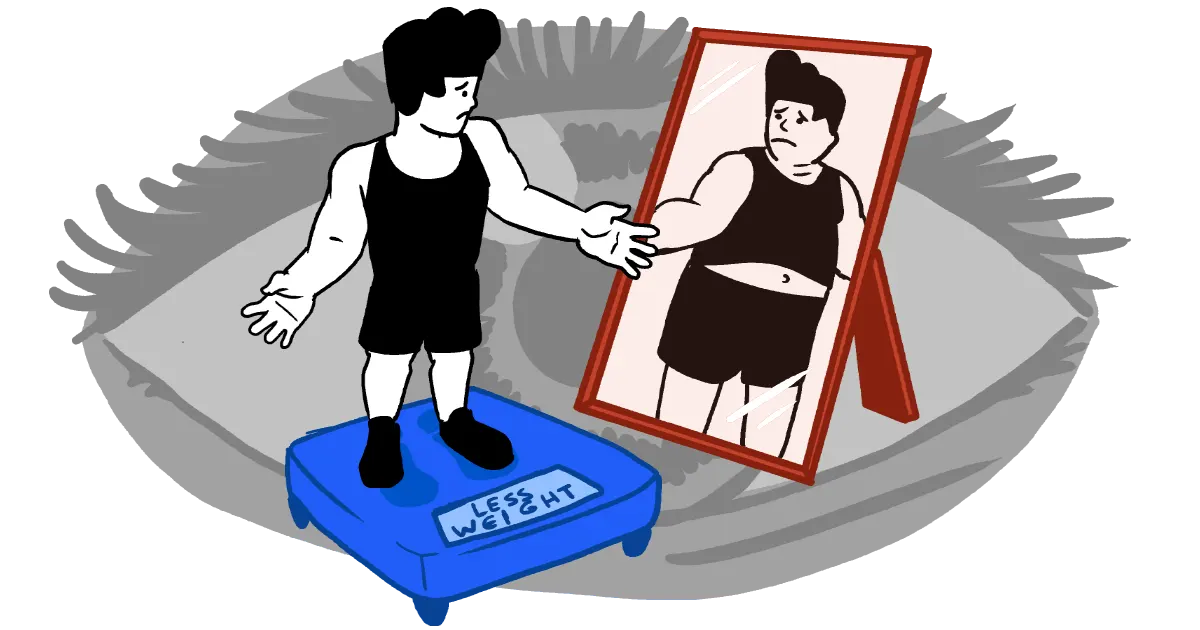
You might be perplexed if you’ve lost weight but appear heavier, questioning why the mirror contradicts the scale’s indications of a slimmer figure. The truth is, a reduction in pounds doesn’t actually mean a smaller dress size and no weight loss coach will tell you this right off the bat because it can be demotivating.
But don’t get down on yourself quite yet.
Once you understand why weight and inches don’t change at the same pace, you’ll realize you’re on the right track and the best way to see results in your physique.
Why Do I Look Fatter Despite Losing Weight?
If you wonder why your body is not responding the way you had hoped – or you don’t have a low body fat percentage, toned muscles, or perfect body shape – this can be due to a multitude of reasons like water retention, bloating, minor dysmorphia, phantom fat, or improper tracking of appearances.
No matter the reason, it can be frustrating to see the number on the scale go down while the look in the mirror stays the same. The best solution is always going to be focusing on consistency and maintaining a healthy diet to get your body in the right place — both physically and mentally.
However, it’s important to understand why you lost weight and look larger so you can address any pesky problems and understand the mechanisms behind each reason.
Water Retention Makes You Look Fatter
One of the main causes of why you may have lost weight but appear fatter is because of water retention. Water retention is a very common cause of bloating and appearing bigger in the stomach area, especially after eating a meal.
The good news about water retention is that it can be easily remedied by making some quick diet and lifestyle changes — even bodybuilders cut water weight to increase the appearance of the lean and defined muscles.1
To reduce water retention, cut out excess carbohydrates because regardless of whether they are complex or simple carbs — they can cause excess water retention and give that bloated look. A low carb diet can help you reduce the bloat too.
Sodium or constantly over-salting your food and eating salty snacks can make your body retain water as well. Salt is usually a remedy used for athletes after excess perspiration to restore natural sodium levels. However, if you are increasing your sodium intake without it being related to higher levels of perspiration/exercise, your sodium balance will be way too high.
Creatine is another culprit that many gym-goers use to help with muscle growth, strength adaptations, and increased athletic performance. However, too much creatine intake can cause water retention, which can play mind tricks on health-conscious individuals.
Bloating = Lost Weight but Look Fatter
If you’re thinking “I lost weight yet my body fat percentage increased“, it’s important to note that excess bloating can cause your belly to look bigger, your pants to fit tighter, and your self esteem to plummet due to the appearance of gaining weight. Although every person gains weight in different places according to genetics and their diet and exercise regime, any person may be susceptible to bloating and it’s just a natural part of being human.
Avoiding certain foods may decrease the bloat and figuring out ways to reduce belly fat overnight can get rid of the uncomfortable bloating feeling too.
Proportions & Retaining Fat in Different Areas
Some individuals may feel like they ‘look bigger’ after losing weight because they gain or lose weight in various areas of their body. Some people retain fat in their stomach, butts, or face, meaning that although they may have lost weight, the fat may be more pronounced in certain areas now that the rest of the body is leaner.
Take this into account — your waist-to-shoulder ratio can significantly influence the appearance of the fat on your body. If you store fat in more noticeable areas, and you lean out or gain muscle in other areas of the body, it can make the fatty areas of your body stand out more than others.
Many people will have varying degrees of fat distribution and body composition, especially as they age.2 In addition, fat tends to jiggle before you lose it in some individuals, so don’t get discouraged.
Phantom Fat & Minor Dysmorphia
Even though you may be putting in extra effort in the gym, kitchen, and life as a whole, it may feel as if you are making very little or no progress. Sometimes, people are just hard on themselves and always expect more. Other times, mental or psychological disorders can cause people to not ‘see’ themselves as they really are.
Some individuals who begin lifting, working out, or adopting a healthy lifestyle can form a sort of phantom fat or minor body dysmorphic disorder. This disorder is when someone does not see their body from a third-person point of view and has a warped sense of their own body. Also known as BDD (body dysmorphic disorder), this condition is when people are preoccupied with slight ‘defects’ or changes in their appearance that can result in negative self reflection.3
Delusional beliefs are sometimes present in those with BDD, appearing in between 32 to 38% of those suffering from this disorder.4 As a result of the preoccupation with a certain area on the body and negative self ridicule, individuals who have BDD typically suffer in other aspects of their life, such as in academic, social settings, workplaces, or relationships.5
Those who have this serious condition can develop a better sense of self and adopt a more positive mindset by being consistent with their positive self-talk, eating a healthy diet, and avoiding extremes. Of course, if this becomes troublesome in any way it’s best to discuss the matter with a healthcare professional (don’t worry, they won’t judge you and are there to help).
How To Look Skinnier & See Results After Weight Loss
Instead of expecting overnight belly fat loss, it’s important to take into account that changes such as losing fat and muscle growth can take some time. By staying consistent with lifestyle alterations, exercise routines, and smart decisions, individuals can see how changes will continue to happen slowly over time, leading to a better level of self esteem and body shape.
Although body composition and genetics can play a role in your body type, where you gain/lose weight, and muscle growth, trusting in the process and tracking your progress can highlight weight loss — or see why you have lost weight but appear fatter.
Take Before & After Pictures

One of the best ways to hold yourself accountable and to increase your self esteem during your weight loss journey — is to take photos of yourself during the process. Starting with a ‘before’ picture of before you began your healthy lifestyle and progress pictures can help you see how the small changes over time are adding up to a healthier picture of yourself.
Take Body Measurements
A second way to see results after weight loss is by taking measurements of specific areas of your body. Body composition and growth are some of the most important components of health in individuals.6 Measuring the size of your biceps, forearms, chest, shoulders, belly, calves, quads, and neck is the best way to see if body composition has changed.
Focus on the major muscle groups on your entire body to see where you have lost or gained weight and the effectiveness of your current exercise and/or dieting plan.
Experiment More
Experimenting with your diet and exercise plan is a great way to see what works for your body and what doesn’t. What may work for your friend might not work for you — some people enjoy being vegan, whereas others find a paleo diet is successful.
Some individuals find that eating extra calories a few days a week can help with weight loss and muscle gain, whereas others find a consistent caloric intake is beneficial.
Instead of always focusing on reducing your calorie intake little by little, focus on a sustainable diet. Some people get too far in a caloric deficit and find it hard to get out of that psychological and physical rut — avoid calorie restriction, as it is only suitable as a limited short-term influence.7 After all, consistent caloric restriction can make your body go into survival mode — an intense physical state that will reduce the speed of your metabolism over time.
Try exercising more. Try exercising less. Try a different diet. Sleep more. Mitigate stress. Doing any one of these things can help you see what works for your unique body type.
Trust in The Process
Short-term fixes and quick fads are not the best way to sustain a healthy lifestyle, but focusing on consistent effort, persistent hard work, and small changes will allow individuals to reap the benefits of their diet, exercise, and lifestyle changes that assist with long-term weight management.8
Instead of wondering why you lost weight but look fatter, make tiny changes that can help you reduce bloating, get rid of water retention, and increase your psychological health to aid in weight loss.9
Small changes to one’s diet and physical activity are successful behaviors for long-term weight management.10 Incorporating small lifestyle, diet, and exercise changes into your life can be all you need to lose weight and feel confident.
References
1Severiche, Luis. (2013). Bodybuilding: Nutrition, Training and Steroids. Booktango. <https://www.barnesandnoble.com/w/bodybuilding-luis-severiche-jr/1115836033>
2Wannamethee, S., Shaper, A., & Whincup, P. (2005). Body fat distribution, body composition, and respiratory function in elderly men, The American Journal of Clinical Nutrition, 82(5), 996–1003, <https://linkinghub.elsevier.com/retrieve/pii/S0002916523296811>
3Singh, A. R., & Veale, D. (2019). Understanding and treating body dysmorphic disorder. Indian journal of psychiatry, 61(1), S131–S135. <https://journals.lww.com/indianjpsychiatry/fulltext/2019/61001/understanding_and_treating_body_dysmorphic.17.aspx>
4Phillips, K., Pinto, A., Hart, A., Coles M., Eisen J., Menard W, et al. (2012). A comparison of insight in body dysmorphic disorder and obsessive-compulsive disorder. J Psychiatr Res., 46, 1293–9. <https://www.ncbi.nlm.nih.gov/pmc/articles/PMC3432724/>
5Phillips, K. (2004). Body dysmorphic disorder: Recognizing and treating imagined ugliness. World Psychiatry, 3, 12–7. <https://www.ncbi.nlm.nih.gov/pmc/articles/PMC1414653/>
6Wells, J. C., & Fewtrell, M. S. (2006). Measuring body composition. Archives of disease in childhood, 91(7), 612–617. <https://adc.bmj.com/content/91/7/612>
7Benton, D., & Young, H. A. (2017). Reducing Calorie Intake May Not Help You Lose Body Weight. Perspectives on psychological science : a journal of the Association for Psychological Science, 12(5), 703–714. <https://journals.sagepub.com/doi/10.1177/1745691617690878>
8Gorin, A., Phelan, S., Wing, R., & Hill, J. (2004). Promoting Long Term Weight Control: Does Dieting Consistency Matter? International journal of obesity and related metabolic disorders, 81(28). <https://pubmed.ncbi.nlm.nih.gov/14647183/>
9Alhalel, N., Schueller, S. M., & O’Brien, M. J. (2018). Association of changes in mental health with weight loss during intensive lifestyle intervention: does the timing matter?. Obesity science & practice, 4(2), 153–158. <https://onlinelibrary.wiley.com/doi/10.1002/osp4.157>
10Hills, A., Byrune, N., Lindstrom, R., & Hill, J. (2013). ‘Small Changes’ to Diet and Physical Activity Behaviors for Weight Management. Obesity Facts, 228(6). <https://pubmed.ncbi.nlm.nih.gov/23711772/>